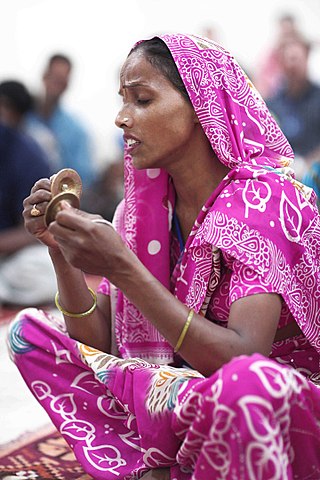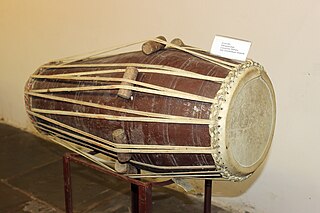Related Research Articles
Dhrupad is a genre in Hindustani classical music from the Indian subcontinent. It is the oldest known style of major vocal styles associated with Hindustani classical music, Haveli Sangeet of Pushtimarg Sampradaya and also related to the South Indian Carnatic tradition. It is a term of Sanskrit origin, derived from dhruva and pada. The roots of Dhrupad are ancient. It is discussed in the Hindu Sanskrit text Natyashastra, and other ancient and medieval Sanskrit texts, such as chapter 33 of Book 10 in the Bhagavata Purana, where the theories of music and devotional songs for Krishna are summarized.
Khyal or Khayal is a major form of Hindustani classical music in the Indian subcontinent. Its name comes from a Persian/Arabic word meaning "imagination". Khyal is associated with romantic poetry, and allows the performer greater freedom of expression than dhrupad. In khyal, ragas are extensively ornamented, and the style calls for more technical virtuosity than intellectual rigour.

Indian classical music is the classical music of the Indian subcontinent. It is generally described using terms like Marg Sangeet and Shastriya Sangeet. It has two major traditions: the North Indian classical music known as Hindustani and the South Indian expression known as Carnatic. These traditions were not distinct until about the 15th century. During the period of Mughal rule of the Indian subcontinent, the traditions separated and evolved into distinct forms. Hindustani music emphasizes improvisation and exploration of all aspects of a raga, while Carnatic performances tend to be short composition-based. However, the two systems continue to have more common features than differences. Another unique classical music tradition from Eastern part of India, i. e. Odissi music has evolved since two thousand years ago.
Ektal or Ektaal is a tala in Indian music. It is commonly used in classical music like kheyal, and semi-classical forms like Rabindra Sangeet. In ektal the 12 matras are divided into 6 vibhags of two matras each. Ektal is played in Drut gatti. This tala is mostly played by the use of tabla. One more tala similar to Ektal is Chowtal which is played with the use of Pakhavaj,Ektaal is the tabla counterpart of Chowtaal. Many beautiful Kaida are played in Ektal. But Ektal is mostly played for Vilambit.
Teentaal is the most common taal of Hindustani music, and is used for drut. It is symmetrical and presents a very simple rhythmic structure against which a performance can be laid. It is of 16 beats with 4/4/4/4/ pattern and 4 divisions.There are 3 claps(tali) and 1 gap(khali).
Hindustani classical music is the classical music of the Indian subcontinent's northern regions. It may also be called North Indian classical music or, in Hindustani, shastriya sangeet. The term shastriya sangeet literally means classical music, and is also used to refer to Indian classical music in general. It is played on instruments like the veena, sitar and sarod. Its origins from the 12th century CE, when it diverged from Carnatic music, the classical tradition in South India. While Carnatic music largely uses compositions written in Kannada, Telugu, Tamil, Malayalam and sometimes in Sanskrit, Hindustani music largely uses compositions written in Urdu, Punjabi, Rajasthani and sometimes in Hindi.

A tala literally means a 'clap, tapping one's hand on one's arm, a musical measure'. It is the term used in Indian classical music similar to musical meter, that is any rhythmic beat or strike that measures musical time. The measure is typically established by hand clapping, waving, touching fingers on thigh or the other hand, verbally, striking of small cymbals, or a percussion instrument in the Indian subcontinental traditions. Along with raga which forms the fabric of a melodic structure, the tala forms the life cycle and thereby constitutes one of the two foundational elements of Indian music.

The pakhavaj is a barrel-shaped, two-headed drum, originating from the Indian subcontinent, the oldest version of double sided drums and its descendants are mridangam of Southern India and kendang of Maritime Southeast Asia and other South Asian double-headed drums. Its older forms were made with clay.
Pandit Kishan Maharaj was an Indian tabla player who belonged to the Benares gharana of Hindustani classical music.
Khamaj is a Hindustani classical Music raga within the Khamaj thaat which is named after it.
The Agra gharana is a tradition of Hindustani classical vocal music descended from the Nauhar Bani. So far, Nauhar Bani has been traced back to around 1300 AD, during the reign of Emperor Allauddin Khilji of Delhi.
Gandharva Mahavidyalaya New Delhi is an institution established in 1939 to popularize Indian classical music and dance. The Mahavidyalaya (school) came into being to perpetuate the memory of Pandit Vishnu Digambar Paluskar, the great reviver of Hindustani classical music, and to keep up the ideals set down by him. The first Gandharva Mahavidyalaya was established by him on 5 May 1901 at Lahore. The New Delhi school follows the syllabi set by the Akhil Bharatiya Gandharva Mahavidyalaya Mandal.
Yakshagana Tala, is a rhythmical pattern in Yakshagana that is determined by a composition called Yakshagana Padya. Tala also decides how a composition is enacted by dancers. It is similar to Tala in other forms of Indian music, but is structurally different from them. Each composition is set to one or more talas, and as a composition is rendered by Himmela, the percussion artist(s) play supporting the dance performance. Tala is maintained by the singer using a pair of finger bells.

A tabla is a pair of hand drums from the Indian subcontinent. Since the 18th century, it has been the principal percussion instrument in Hindustani classical music, where it may be played solo, as an accompaniment with other instruments and vocals, and as a part of larger ensembles. It is frequently played in popular and folk music performances in India, Bangladesh, Afghanistan, Pakistan, Nepal and Sri Lanka. The tabla is an essential instrument in the bhakti devotional traditions of Hinduism and Sikhism, such as during bhajan and kirtan singing. It is one of the main qawwali instruments used by Sufi musicians. The instrument is also featured in dance performances such as Kathak. Tabla is a rhythmic instrument.
Jhaptal is a tala of Hindustani music. It presents quite a different rhythmical structure from Teental, unlike which it is not symmetrical. It is used in madhyalay (medium-tempo) Khyal.

Borgeets are a collection of lyrical songs that are set to specific ragas but not necessarily to any tala. These songs, composed by Srimanta Sankardeva and Madhavdeva in the 15th-16th centuries, are used to begin prayer services in monasteries, e.g. Satra and Namghar associated with the Ekasarana Dharma; and they also belong to the repertoire of Music of Meghalaya outside the religious context. They are a lyrical strain that express the religious sentiments of the poets reacting to different situations, and differ from other lyrics associated with the Ekasarana Dharma. Similar songs composed by others are not generally considered borgeets.
Tilwada or tilwara is a tala of Hindustani music. Like tintaal, tilwada tala also has 16 beats. Tilwada is often used in Kheyal.
Jhoomra is a tala of Hindustani music. Jhoomra tala has 14 beats. Jhoomra is often used in the vilambit or ati-vilambit (slow) Khyal.

Gokulotsavji Maharaj is a Hindustani classical musician, specializing in Khayal, Dhrupad Dhammar, Prabandh Gayaki and various other ancient indian musical styles. He is also a singer-cum-composer, writer, poet, and musicologist.
Ṭa is a consonant of Indic abugidas. It is derived from the early "Ashoka" Brahmi letter after having gone through the Gupta letter . As with the other retroflex consonants, ṭa is absent from most scripts not used for a language of India.
References
- ↑ Shrivastava, Harish. Raag Parichay 2. Sangeet Sadan Prakashan.
